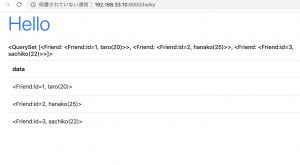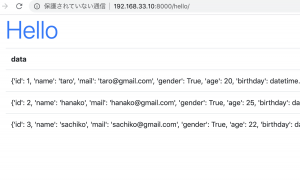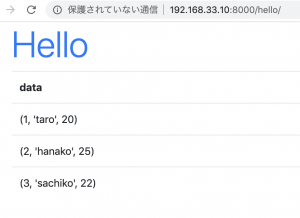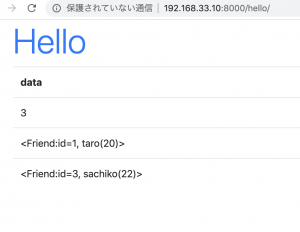### モデルのリストを調査
/hello/views.py
from django.shortcuts import render
from django.http import HttpResponse
from .models import Friend
def index(request):
params['data'] = Friend.objects.all()
params = {
'title': 'Hello',
'data': data,
}
return render(request, 'hello/index.html', params)
/hello/templates/hello/index.html
from django.shortcuts import render
from django.http import HttpResponse
from .models import Friend
def index(request):
data = Friend.objects.all()
params = {
'title': 'Hello',
'data': data,
}
return render(request, 'hello/index.html', params)
– .objects.all()で取り出していたのはQuerySetというインスタンスだということがわかる
– QuerySetには__str__も含む

### valuesメソッド
– .objects.values()で辞書でデータを取り出すことができる
/hello/views.py
def index(request):
data = Friend.objects.values()
params = {
'title': 'Hello',
'data': data,
}
return render(request, 'hello/index.html', params)

– 特定の項目を指定
def index(request):
data = Friend.objects.values('id', 'name')
params = {
'title': 'Hello',
'data': data,
}
return render(request, 'hello/index.html', params)
– リストとして取り出す
data = Friend.objects.all().values_list('id', 'name','age')

– first最初、last最後、countレコード数
def index(request):
num = Friend.objects.all().count()
first = Friend.objects.all().first()
last = Friend.objects.all().last()
data = [num, first, last]
params = {
'title': 'Hello',
'data': data,
}
return render(request, 'hello/index.html', params)

– QuerySetのカスタマイズ
from django.shortcuts import render
from django.http import HttpResponse
from .models import Friend
from django.db.models import QuerySet
def __new_str__(self):
result = ''
for item in self:
result += '<tr>'
for k in item:
result += '<td>' + str(k) + '=' + str(item[k]) + '</td>'
result += '</tr>'
return result
QuerySet.__str__ = __new_str__
def index(request):
data = Friend.objects.all().values('id', 'name', 'age')
params = {
'title': 'Hello',
'data': data,
}
return render(request, 'hello/index.html', params)
<body class="container">
<h1 class="display-4 text-primary">{{title}}</h1>
<table class="table">
{{data|safe}}
</table>
</body>
reverseなどもviews.pyで整形すれば良いのですね、少しイメージが湧いてきました。
